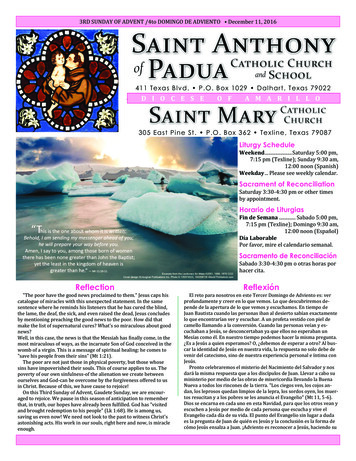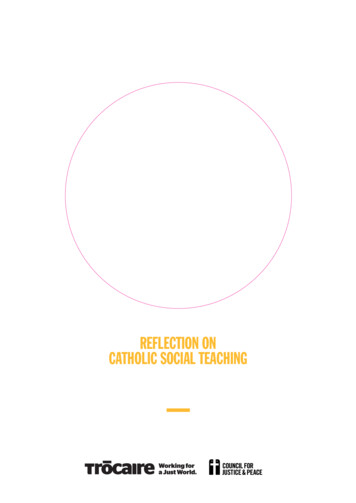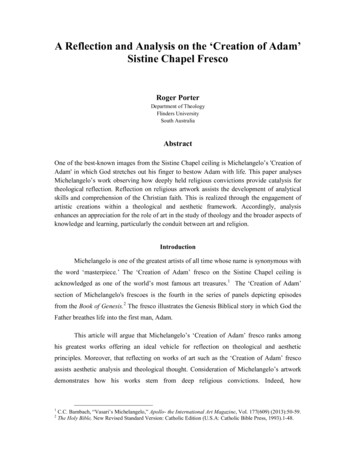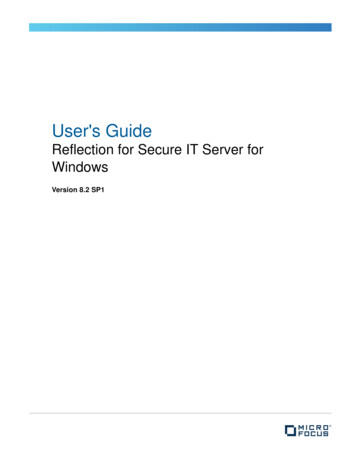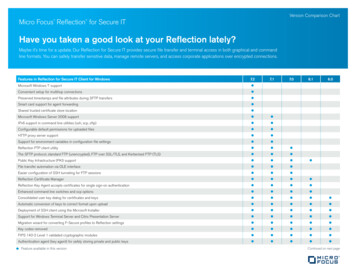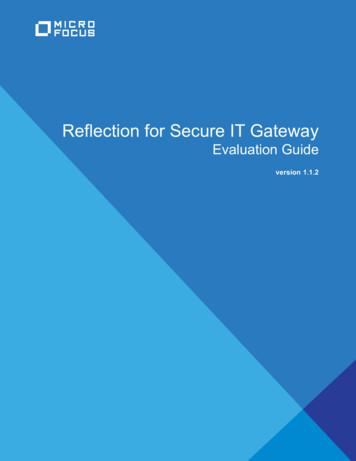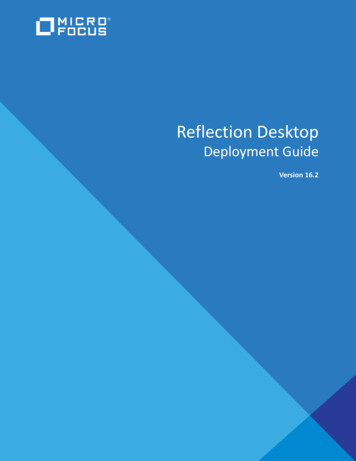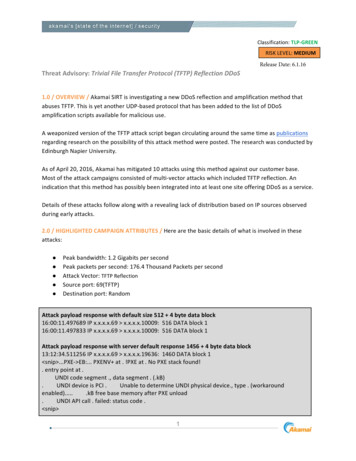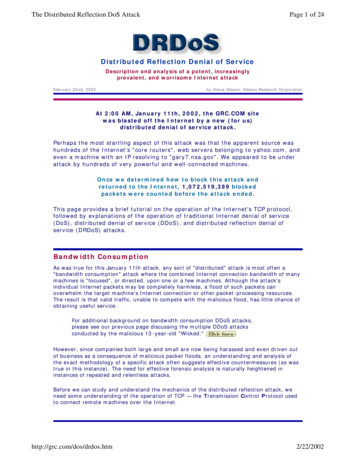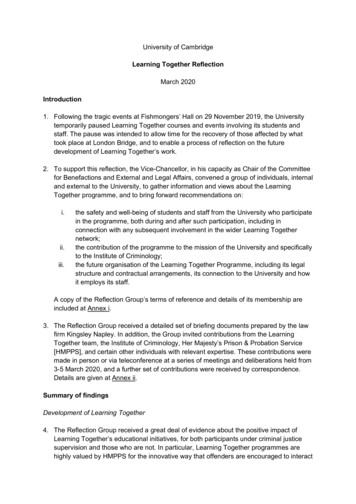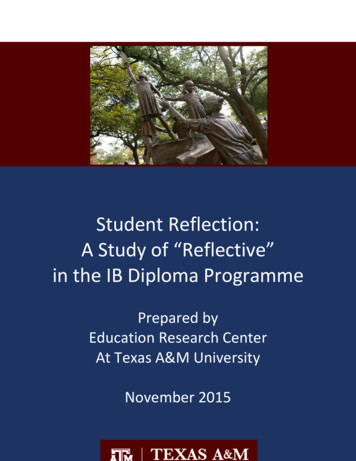
Transcription
Student Reflection:A Study of “Reflective”in the IB Diploma ProgrammePrepared byEducation Research CenterAt Texas A&M UniversityNovember 2015
This page has been intentionally left blank.ii
Student Reflection:A Mixed Method Study of “Reflective”in the IB Diploma ProgrammeNovember 2015Submitted to:International Baccalaureate OrganizationPrepared by:Education Research Center at Texas A&M Universityiii
CreditsContributing AuthorsEducation Research Center atTexas A&M UniversityEducation Research Center atTexas A&M University:The Education Research Center (ERC) at TexasA&M University (TAMU) studies major issues ineducation reform and school governance inorder to improve policy and decision-making in P16 education.Jacqueline R. StillisanoKim B. WrightAnna W. BoriackTracey S. HodgesSunni SonnenburgSandra MetoyerKayla B. RollinsHersh C. WaxmanFor additional information about ERC at TAMUResearch and evaluation, please contact theFollowing:Submitted to:Education Research Centerat Texas A&M University112 Harrington Tower4232 TAMUCollege Station, TX 77843-4232erc.cehd.tamu.eduInternational Baccalaureate OrganizationResearch Funded by:International Baccalaureate Organizationiv
Executive SummaryThe International Baccalaureate (IB) was founded in 1968 as an educational program provider forgeographically mobile students enrolled at international schools. Its programs have grown significantlyover the past 10 years and today are provided to well over a million students and 4267 schools in 147countries, and the IB diploma is accepted worldwide as a gateway for entrance into the best and mostrigorous universities (Burris, Welner, Wiley, & Murphy, 2007; Hill, 2012). The IB curriculum is offeredthrough four IB programs: the Primary Years Programme (PYP), the Middle Years Program (MYP), theDiploma Programme (DP), and the Career-Related Programme (CP). All IB programs encourageacademic and personal achievement, inspiring students to excel in their studies and in their personalgrowth (International Baccalaureate Organization [IBO], 2015a).IB programmes, including the DP, support student attainment of a range of 10 academic and nonacademic attributes that are collectively described as the Learner Profile (IBO, 2015d). The LearnerProfile represents targets and values that become part of a school’s culture and ethos when theinstitution is authorized as an IB World School. At the student level, the attributes and descriptors ofthe Learner Profile define the type of learner the IB hopes to develop through its programs. At theschool level, the Learner Profile is a set of ideals that can inspire, motivate and focus the work of schoolsand teachers. Schools are expected to consider how structures and systems, curricula, and units of workcan enable students to develop into the learner described in the profile.The Education Research Center at Texas A&M University (ERC at TAMU) was commissioned by the IBOto conduct a research study focusing on the Learner Profile attribute, reflective. In this study ERCresearchers examined the implementation of the attribute by exploring how reflective is interpreted,how it is integrated into instruction and activities, how it is assessed, and how it benefits DP students.Researchers employed a 4-stage, mixed methods design as the framework for the study: (a) exploration,(b) identification, (c) investigation, and (d) comparison.Researchers began the study by completing a best-evidence synthesis review of the literature (Slavin,1986, 2009) on reflective thinking in secondary education settings. Results from the literature review (a)provided a framework for describing and recognizing reflective teaching practices, examples ofreflection activities, and ways to facilitate and assess reflective thinking and learning; (b) identifiedbenefits of student reflection in secondary school education; and (c) informed the development of theReflective Instruction Survey for Teachers and Administrators (RISTA).In the identification phase, researchers worked with the IB’s research department to identify a largesample (n 835) of IB DP schools in the US and Canada as potential recipients of the RISTA. Schoolswere further sorted by application of stratifying criteria, resulting in 213 schools that were invited toparticipate in the study. Of the 213 schools contacted, 31 responded affirmatively.In the examination phase, ERC researchers administered the RISTA to teachers and administrators in 31DP schools in the US and Canada. Survey results were used to identify ways in which the sample of DP1
teachers and administrators interpreted reflective and the significance of the attribute in the written,taught, and learned curriculum. Survey responses were also used to identify six U.S. and Canadianschools that had successfully integrated instruction of reflective, as participants for in-depth casestudies.Each case (DP school) was first investigated and analyzed as a comprehensive, individual case (Merriam,2009). Data were collected from each site to allow the research team to examine unique contextualfactors might pertain to the case, and case narratives were developed for each case study site.Pseudonyms were assigned to schools and respondents in order to protect participants’ confidentialityto the fullest extent possible.Teams composed of researchers from the ERC at Texas A&M University collected data at the six schoolschosen to participate, using classroom observation, student survey, and teacher and administratorinterview instruments developed and adapted by the evaluation team specifically for this particularstudy. The Teacher Roles Observation Schedule–IB (TROS–IB) was used to systematically documentobserved teacher behaviors in the context of ongoing classroom instruction. Each teacher was observedfor six to ten 30-second intervals during each classroom observation, allowing researchers to collectdata to examine (a) teacher interactions with students, (b) use of various instructional settings, (c)reflective instructional practices, and (d) nature of teacher-student interaction in the classrooms visited.With regard to overall observed reflective practices, teachers were most frequently observedhighlighting main or important points of lessons, soliciting multiple perspectives from students, andproviding time for reflection. Critical reflective practices were evidenced in approaches such as Socraticcoaching/questioning but were not frequently observed during our period of data collection. As such,this may be an area where the IB could provide further guidance to DP schools and teachers.The Observation of Features for International Baccalaureate Program Instrument (OFIBP) was used atthe end of class visitations to measure on a 3-point scale of Not observed at all, Observed to someextent, and Observed to a great extent the degree to which certain instructional processes or strategieswere used or demonstrated during the class period. Instruction in most of the schools was observed tobe student-centered, with teachers initiating experiences or activities and students being given theopportunity to further develop concepts on their own. In the classrooms observed, teachers wereprimarily evaluating student learning and providing feedback, while students were providedopportunities to be active participants in their learning.The IB Student Reflective Thinking Questionnaire (IB–SRTQ) was administered to DP students aged 18and older at the individual case study sites, to assess their perceptions of their reflective thinking. Thesurvey, which was adapted from the Reflective Thinking Questionnaire (RTQ; Kember et al., 2000),utilized the four scales from the original RTQ: habitual action, understanding, reflection, and criticalreflection. Overall, students surveyed perceived most strongly that their DP courses requiredunderstanding (M 13.31, SD 1.69) and perceived least strongly that DP courses could be successfullycompleted through habitual action practices (M 8.86, SD 1.88), such as memorization.2
Qualitative data were gathered through in-depth interviews with teachers and administrators affiliatedwith the DP in their individual schools. Through an inductive analysis of the data, researchers firstidentified (a) themes and issues related to schools’ individual understanding of reflective policies andpedagogical practices supporting reflection and (b) perceived benefits of reflective and reflectivethinking for DP students.In the final phase, comparison, researchers conducted a cross-case analysis (Merriam, 2009; Stake,2006) to explore policies and practices across the case study sites that facilitate or inhibit studentengagement with reflective thinking and identify learning outcomes that DP administrators, teachers,and students ascribe to reflective thinking. The final analysis also provides a rich description of the casestudy sites, with emphasis on site-specific outcomes identified as emerging from interpretations ofreflective and strategies for integrating reflective thinking.3
IntroductionFounded in 1968, International Baccalaureate (IB) programmess have grown significantly over the past10 years and today are provided to more than 1,300,000 students and 4267 schools in 147 countries.The IB curriculum is offered through four IB programmes: the Primary Years Programme (PYP), theMiddle Years Programme (MYP), the Diploma Programme (DP), and the Career-Related Programme (CP).All IB programmess encourage academic and personal achievement, inspiring students to excel in theirstudies and in their personal growth (International Baccalaureate Organization [IBO], 2015a).IB programmes, including the DP, support student attainment of a range of 10 academic and nonacademic attributes that are collectively described as the Learner Profile (IBO, 2015d). The LearnerProfile reflects targets and values that become part of a school’s culture and ethos when the institutionis authorized as an IB World School. At the student level, the attributes and descriptors of the LearnerProfile define the type of learner the IB hopes to develop through its programs. At the school level, theLearner Profile is a set of ideals that can inspire, motivate and focus the work of schools and teachers.Schools are expected to consider how structures and systems, curricula, and units of work can enablestudents to develop into the learner described in the profile.The focus of the current study is the Learner Profile attribute, reflective. In this study, researchersassessed the reflectivity of students completing the DP, and documented the ways—and to whatextent—reflective is recognized and incorporated in the DP by students, teachers, and administrators inIB World Schools. Specifically, researchers implemented a mixed-methods design to accomplish thefollowing research objectives: Examine ways in which DP teachers, administrators, and students in IB World Schools definethe Learner Profile attribute, reflective. Explore teachers’ and students’ perceptions of the role of reflective in the DP. Investigate ways in which school policies, pedagogical practices, curricula, and extracurricularactivities support student reflection in DP schools. Document the extent to which IB Diploma students exhibit evidence of (a) reflective thinkingand (b) the capacity to learn through reflection.Theoretical BackgroundAs a leader in international education, the IBO supports schools in providing students with challengingacademic programs that encourage critical thinking from an intercultural perspective (Nugent & Karnes,2002). The Diploma Programme has grown steadily since its inception, with the 2013 IB annual reviewreporting 70,627 Diploma candidates in 2611 schools worldwide (IBO, 2013b). Although the programmewas originally intended to prepare geographically mobile students enrolled in largely privateinternational schools, the IBO currently serves students from socioeconomically diverse backgrounds inpublic and private schools alike (Hill, 2012; IBO, 2013a). The IB diploma is accepted worldwide as a4
gateway for entrance into the best and most rigorous universities (Burris, Welner, Wiley, & Murphy,2007; Hill, 2012).Based on two years of study and discussion among the IBO and schools around the world, the IB LearnerProfile was established in 2006 as a new facet of the Diploma Programme. The Learner Profile convertsthe mission statement of the IB into learning practice for IB learners and into exemplars that focus thework of teachers and schools, explicitly delineating a list of 10 academic and non-academic qualities theIB strives to inculcate in its students in order for them to develop as life-long learners (Hill, 2012; IBO,2006). IB learners strive to be (a) inquirers, (b) knowledgeable, (c) thinkers, (d) communicators, (e)principled, (f) open-minded, (g) caring, (h) risk-takers, (i) balanced, and (j) reflective (IBO, 2013c).Reflective, an attribute in the Learner Profile and the focus of this study, is delineated as follows:“[Students] give thoughtful consideration to their own learning and experience. They are able to assessand understand their strengths and limitations in order to support their learning and personaldevelopment” (IBO, 2015d).Reflective thinking is a complex attribute that has many components or factors. Sometimes referred toas self-regulated learning (Schunk & Zimmerman, 2013) or as metacognition (Schraw & Dennison, 1994),factor analyses of surveys designed to measure reflective thinking provide support for at least twocomponents: (a) knowledge about cognition and (b) regulation of cognition. Knowledge about cognitionincludes knowledge about learning strategies and knowing how and when to use different cognitivestrategies (Baker, 2013). Regulation of cognition includes skills required for self-regulation of learning:planning, managing information, self-monitoring, identifying alternative strategies, and assessing one’sown progress (Schraw & Dennison, 1994; Madj
The IB Student Reflective Thinking Questionnaire (IB–SRTQ) was administered to DP students aged 18 and older at the individual case study sites, to assess their perceptions of their reflective thinking. The survey, which was adapted from the Reflective Thinking Questionnaire (RTQ; Kember et al., 2000), utilized the four scales from the original
